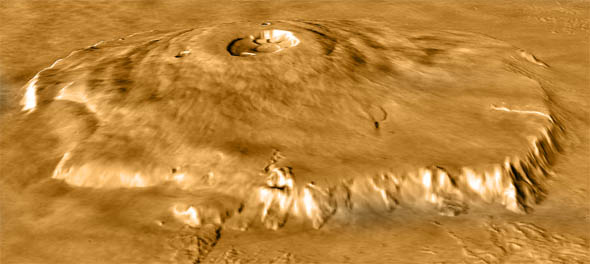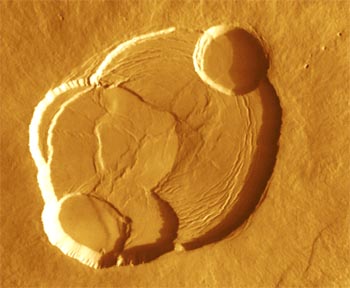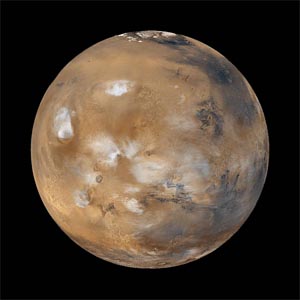 Olympus
Mons: The Mega-Volcano
Olympus
Mons: The Mega-Volcano

In 2013
scientists announced a startling discovery: At the bottom of the
Pacific Ocean they had discovered a gigantic volcano. This inactive
behemoth, which has been quiet for 140 million years, is a thousand
miles east of Japan, rises 2 miles up from the ocean floor and
has a base about 400 miles wide. Scientists have named the submerged
peak Tamu Massif.
As massive
as this volcano is, however, it is only the second largest one
in our solar system. That particular accolade belongs to Olympus
Mons on the planet Mars. Its base is similar in size to Tamu
Massif's, but it height is much greater: It reaches a staggering
14 miles into the Martian sky from its cliff base on its northeast
edge. The land area covered by this monster is an immense 113,998
square miles, about the same size as the state of Arizona.
Discovery
|
Seven
Quick Facts
|
| Height:
14 miles (22km) |
| Base
Width: 370 miles (600km) |
| Age:
Less than 100 million years. |
| Type
of feature: Shield volcano located on Mars |
| Size:
113,998 square miles (295,254 square km) - about the same
as the state of Arizona. |
| Discovery:
First identified as a volcano in 1971 by Mariner 9 spaceprobe |
| Other:
May still be active and erupt again at a future date |
One of
the first persons to guess that there was something special about
this location on Mars was the Italian astronomer Giovanni Virginio
Schiaparelli. Schiaparelli spent a lot of time in the second half
of the 19th century staring at the red planet through his telescope.
He thought he'd observed natural areas on the surface that he
referred to as channels. This term was later mistranslated into
English as "canals," spurring speculation at the time that they
were waterways built by an intelligent Martian population.
Eventually
better telescopes allowed scientists to reach the conclusion that
the channels were just optical illusions . However, one feature
that Schiaparelli saw that was later proved to actually exist
was a light spot he named Nix Olympica (which means Olympic
Snow). Schiaparelli came to the conclusion that this object
must be the peak of a humongous mountain as it was one of the
few surface features that could still be seen during Mars' frequent
dust storms.
Nix Olympica
kept its name for a century until an unmanned probe launched by
NASA went into orbit around the red planet and began taking detailed
pictures of the surface. Mariner 9 arrived at Mars on November
14, 1971, in the middle of a huge dust storm. As the clouds subsided,
pictures soon revealed that Nix Olympica was not just a big mountain,
but a massive volcano that dominated the western hemisphere of
the Martian surface. To reflect the mountain's new status, the
name was changed from Nix Olympica to Olympus Mons (which means
Mount Olympus in Latin).
|

This
photo shows the overlapping calderas at the top of the mountain.
(NASA)
|
Geology
Scientists
believe that Olympus Mons is what is known as a shield volcano.
Shield volcanos are given that name because they resemble a warrior's
shield laid face up on the ground. They are very large with a
low, dome-like profile. They are created by a series of lava flows
that slowly build up the mountain over an immense period of time.
The volcanos of the Hawaiian islands and the newly-discovered
Tamu Massif are examples of shield volcanos here on Earth.
Shield
volcanos differ from the more well- known stratovolcanoes in shape
and behavior. A stratovolcano starts with a gentle slope that
becomes increasingly steep as you near the peak. Stratovolcanoes
often have violent, destructive eruptions that can sometimes blow
away large sections of mountain and produce huge amounts of ash.
Mount St. Helens in the USA and Mount Vesuvius, Italy,(which famously
leveled the ancient Roman city of Pompeii) are examples of stratovolcanoes
here on Earth.
Shield
volcanos rarely erupt explosively. Instead, they repeatedly discharge
large lava flows that slowly build up the dome of the mountain.
Shield volcanos on Earth often form over "hotspots." These are
locations where the heat from deep down in the center of the Earth
seems to rise into the crust. Scientists aren't exactly sure what
causes a hotspot, but the heat melts the rock to create a magma
chamber under the volcano. During an eruption, some of this molten
rock is pushed up and out through the volcano's crater to create
a lava flow.
|
How
do we measure Olympus Mon's height?
On Earth, we
typically measure the height of a mountain from the peak
down to sea level. For example, the top of Mt. Everest is
29,029 feet above sea level (about 5.4 miles or 8.8 km).
On Mars, there is no sea to measure from, so this doesn't
work. Another way of measuring a mountain, however, is from
its top down to its base. If you do this, the tallest mountain
on earth is Mauna Kea in Hawaii. It is33,480 feet high (6.3
miles or 10.3 km) but most of it is underwater. Mt. Everest
is much smaller with a base to peak height of only 15,300
feet (2.9 miles or 10.2 km). In either case Olympus Mons
with a base to peak height of 14 miles dwarfs them both.
|
Why
Is It So Big?
While
shield volcanos on Earth are some of the largest types of volcanos,
their size may be limited by plate tectonics. The crust of the
Earth is divided into large continental-sized plates that drift
and change position over millions of years. Because the hotspot
will often stay fixed under the plate, this means that the shield
volcano on top will go extinct as the plate carries it away.
An example
of this action can be seen in the Hawaiian Island chain. Each
island was created by a shield volcano. As the Pacific plate moved
northwest, it carried the older islands away from the hotspot
and their volcanos went extinct. Currently, the hotspot is under
the Big Island of Hawaii where the active volcano Mauna Loa sits
today. Eventually Mauna Loa will be carried away, become extinct,
and a new shield volcano will form over the hotspot.
Unlike
Earth, however, Mars doesn't have mobile tectonic plates. For
this reason, Olympus Mons was able to sit over its hotspot for
its entire history as it grew larger and larger. Scientists aren't
sure how old the mountain is, but the lack of meteor craters on
its flanks suggest that it started forming relatively recently,
probably less than 100 million years ago. Some of the lava flows
look like they might only be a couple of million years old, leading
scientists to speculate that the volcano is still active and may
erupt again in the future.
Examining
photos from space probes that scientists have can see at least
six collapsed craters (also known as calderas) overlapping each
other. Each caldera represents a time in the past when the mountain
erupted. When the eruption was over, the magma flowed back out
of the underground chamber in the mountain. The roof then collapsed
on the empty space creating the caldera.
Not
Easy to See
|

This
picture of Mars shows clouds forming around high elevation
sites. The cloud system to the far left surrounds Olympus
Mons (NASA)
|
If you
could visit Mars and stand on the top of the Olympus Mons you
would find the calderas spectacular. However, you would have no
idea from just looking around you that you were on the top of
a huge mountain. Olympus Mons is so large and its slope so gentle
(only about 5 degrees) that everything you see around you would
be part of the mountain. In the same way, if you were standing
next to the mountain you might be able to observe some of the
cliffs that make up its edges, but you would be unable to observe
the mountain as a whole.
The size
of the monstrous peak may also just be a product of its location
on Mars. Mars is a smaller planet than Earth with a lower gravity.
This may have allowed lava to pile up more quickly than it does
on Earth, creating a higher mountain.

Copyright Lee Krystek
2014. All Rights Reserved.






